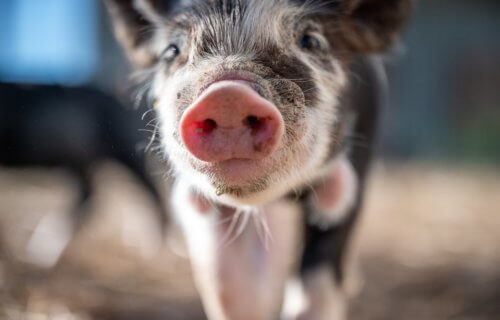COPENHAGEN, Denmark — A team of European scientists has successfully decoded a pig’s emotions. After analyzing over 7,000 acoustic recordings of grunts from over 400 pigs, researchers have become the first in the world to decode pig grunts into identifiable emotions recognizable across a diverse array of conditions and life stages.
Led by scientists from the University of Copenhagen, ETH Zurich, and France’s National Research Institute for Agriculture, Food and Environment (INRAE), study authors say these findings can help improve pig and animal welfare all over the world.
Researchers collected the pig grunt recordings across a variety of different situations among pigs throughout their lives, from birth right up until death. The recordings included the pigs’ reactions to both positive and negative events. Using those 7,000 recordings, the research team developed a special algorithm capable of decoding whether a specific pig is experiencing positive emotions (happy, excited), negative emotions (scared, stressed), or even somewhere in between.
“With this study, we demonstrate that animal sounds provide great insight into their emotions. We also prove that an algorithm can be used to decode and understand the emotions of pigs, which is an important step towards improved animal welfare for livestock,” says study co-leader Associate Professor Elodie Briefer, from Copenhagen’s Department of Biology, in a university release.

What makes a pig happy or sad?
Scientists recorded these sounds in both commercial and experimental situations. Based on each pig’s behaviors while making the grunts, the team associated them with either a positive or a negative emotion. A positive situation, for example, would be when piglets suckle from their mothers, or when a pig reunites with its family. Negative situations include fights, separations, castration, and slaughter.
In more experimental simulations, study authors created numerous “mock scenarios” for the pigs, with each one designed to evoke more nuanced, specific emotions. Examples include an arena with toys or perhaps food and a corresponding arena without any of that stimulus. Oftentimes, researchers would place new objects for the pigs to interact with in the arenas. The team monitored all the pigs’ grunts, calls, behaviors, and heart rates during this exercise.
Then, they analyzed the recordings in an attempt to identify any patterns in the sounds as a function of the pigs’ emotions. If so, could humans differentiate positive emotions from negative ones? As previously reported across earlier studies, higher frequency sounds (squeals, screams) tend to occur more during negative situations. Meanwhile, low frequency calls like barks and grunts are more ubiquitous, occurring during both positive and negative situations.
How can this benefit farmers?
The findings regarding the extreme ends of the emotional spectrum (happiness and sadness) are already notable, but study authors say they were especially fascinated by what they discovered regarding more subtle, nuanced emotions. Further analysis of the sound files revealed a further pattern showing what the pigs felt in various situations in even greater detail.
“There are clear differences in pig calls when we look at positive and negative situations. In the positive situations, the calls are far shorter, with minor fluctuations in amplitude. Grunts, more specifically, begin high and gradually go lower in frequency. By training an algorithm to recognize these sounds, we can classify 92% of the calls to the correct emotion,” Prof. Briefer explains.
Research into the emotional states of animals is a relatively new scientific frontier that has only emerged over the past 20 years or so. Today, however, it is starting to become widely accepted and understood that the mental health of livestock is quite important for their overall well-being. Farmers are still in need of ways to actually monitor animals’ emotions, though.
“We have trained the algorithm to decode pig grunts. Now, we need someone who wants to develop the algorithm into an app that farmers can use to improve the welfare of their animals,” Prof. Briefer concludes.
The findings appear in the journal Scientific Reports.
